

The "Magicar"
started its life in the mind of Kent Fuller... a place where
many of drag racing's finest concepts were born. By the summer
of 1964 Fuller, who many believed to be the best dragster chassis
builder in the country, decided to bring to life a few ideas
that had been floating in his head for a while. Ideas that would
eventually be used successfully in other cars to come, but needed
to be tried in his next creation.
Fuller was never
one to sketch out (blueprint) his ideas. He simply built them.
And his creative juices were in full swing at the back of his
latest beast. Rear suspension in front motor dragsters seemed
unnecessary to most back then. To that point 99 percent of the
rear ends placed in dragster chassis were solidly mounted to
the frame. Why bother when the track surface was, for the most
part, flat? And more importantly -- why mess with success? But
"success" for Fuller, had come from being creative,
and he was known for throwing "something different"
in each of his cars. So when he looked to find more traction,
he came up with ladder bars! The drive train: motor, drive line,
and rear end would be solidly mounted to the ladder bars, and
would shift within the chassis! A pivot point would be towards
the back of the motor, where, on either side, the ladder bars
would be bolted to the frame. And then, just in behind the rear
axle housing, springs would allow the back of the drive train
to transfer dynamic loads to the slicks. So, (under acceleration)
the motor would lift back, the slicks would "plant",
but at the same time, the roll cage would lift, and the front
end would plant. A type of "scissor effect" that would
make the car transfer weight like it was doing a "wheelie",
without ever leaving the ground! Brilliant! Then up front came
the addition of rubber biscuits to take the place of the standard
leaf spring or torsion bar. The almost singular pivot point,
provided a cushioned suspension and great flexibility at the
front end. Even the steering linkage for the car was a work of
art. The steering box lay just ahead of the "butterfly"
steering wheel with it's cross shaft to the right of the box.
From there, the steering link moved forward underneath the right
side body panels and surfaced just ahead of the motor. The tie
rod, up front, crossed over the nose, with single radius rods
holding the front axle in place. Now all that was needed was
a "team" to field the car. And that team materialized
in the form of Ron and Dennis Winkel and Kaye Trapp.
Ace motor man,
Ron Winkel of "Winkel/Wenderski", was without a car
and driver. The highly publicized "Black Beauty" fueler
was running at San Diego Raceway, in Ramona, California when
its pilot, John Wenderski lost control and was killed in the
ensuing crash. So, after a while, Winkel joined forces with Kaye
Trapp a professional drag racing photographer. Along with Ron's
brother Dennis, the team of Winkel, Trapp, Fuller, was created.
The driving chores were to be handled by Gary Casady, an experience
dragster pilot. The combination sounded "unstoppable"
on paper. A reliable motorman, a publicist, and a radical fuel
dragster. The need for outstanding performance was great. But
for reasons that can only be described as "fate", the
car's performance was inconsistent. A real let down for the team,
after so much media hype.
And now, in pictures
and print, is the history of the "Magicar".

Fuller never
sketched out his ideas, but his long time friend Don Tubbs, did
a great job capturing what Fuller brought to the jig. This drawing
created during the car's inception.

Kent Fuller demonstrates the
flexibility of the unique front suspension to Harry Hibler. Ron
Winkel (hand on roll bar) and driver Gary Casady (shades) join
the crowd of interested spectators.
Photo by Kaye Trapp
Rarely has a dragster ever received
such attention. Created by Drag Racing Hall of Fame member, Kent
Fuller the "Magicar" rode high on Fuller's earned reputation
when it debuted in October of 1964.
Drag racing reporters of the
time spared no ink on the car upon it's racing debut.
"The area
surrounding the starting line suddenly resembled the first annual
convention of chassis builders. Woody Gilmore, of Race Car Engineering,
Roy Steen of Race Car Specialties, and the Maestro behind those
Fuller chassis' -- Kent Fuller himself. Why were they here? What
was about to happen? Tonight was the unveiling of the long rumored
Fuller-Trapp-Winkel "Magic Car".
"Drag News" 11-7-64.
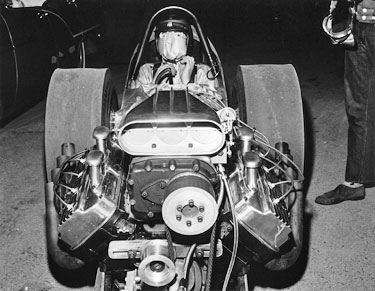 Gary
Casady gets ready to make one of the very first
shakedown runs for the "Magicar".
Gary
Casady gets ready to make one of the very first
shakedown runs for the "Magicar".
Photo by
Kaye Trapp
The magic in the "Magicar"
came from its unique chassis design. Quoting the September 1965
issue of "Drag Racing Magazine": "It was a radical
new chassis concept--a suspended engine and drive train".
"Basically the whole power train is mounted in a separate
sub-frame which is suspended on coil springs within the main
chassis. The engine, then is an isolated, cushioned component.
Its horrendous vibration isn't transferred directly to the car's
main structure and its weight is allowed to shift rearward slightly
for added bite coming off the line."
All the high expectations by
everyone in the drag racing world put a lot of pressure on the
team to perform in an outstanding (and almost impossible) fashion.
However at the height of all the publicity, the car's performance
was less than spectacular and ultimately contributed to a decline
in orders for Fuller dragsters.
Never-the-less, during that first
year of competition as the Winkel, Trapp, & Fuller "Magicar"
appeared at 26 drag races, obtained a best e.t. of 7.62 seconds
and a top speed of 204.08 miles per hour. It won 3 top eliminator
trophies and took top speed honors at Fremont and Palmdale. Three
driver changes made for mixed performance results. Cassidy struggled
with the car in the first few months. Then came "Jumpin'
Jeep" Hampshire who got the most from the car. Hampshire
was so confident of the car's handling that he said he could
drive it with "no hands". Lastly came an unknown
named Gerry Glenn. The "Magicar" was Glenn's first
ride down the strip in anything! So once again, the car's
performance was hampered, for a short time, while Glenn came
up to speed. Five years later, in another car Gerry "The
Hunter" Glenn became the NHRA's Top Fuel Champion.
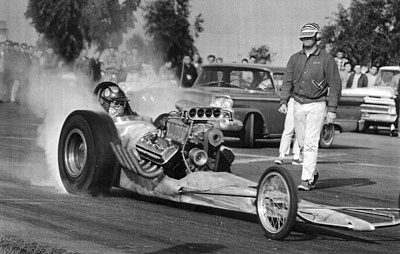
The "Magicar"
finally found it's match when ace pilot "Jumpin' Jeep"
Hampshire took the seat. Here, armed with the motor from the
Stellings & Hampshire "Red Stamp Special", Jeep
proved that the car lay down some numbers. This is when the "Magic"
started to appear.

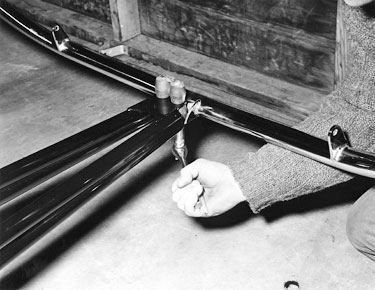
One time when
the car was torn down in Ron Winkel's garage, Kaye Trapp decided
to take some pictures of the car's inner working's. Here, Fuller
himself demonstrates the adjustability of the front suspension
(above) and the rear suspension below.
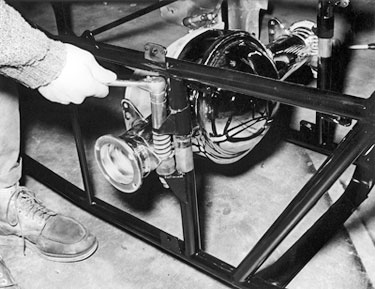

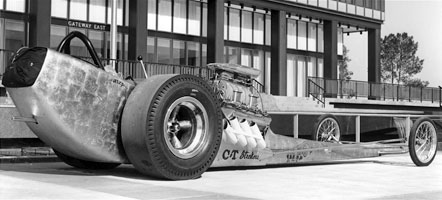
Kaye Trapp and
a friend covered the car entirely in gold leaf, the "Magicar"
was definitely a "Standout". You either loved the look
or.... not. Below, Staats adds the finishing touches to
Jeep's helmet as the first "paint job" is applied --
layed over Dutchman's gold leaf..
Kaye Trapp
Photos


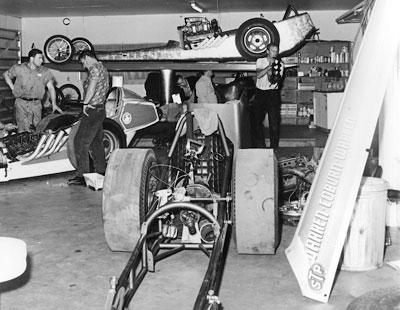
The work is frenzied
in Kenard Warren's garage the night before the 64 car field would
do battle at the 1965 "March Meet" in Bakersfield,
California. The "Magicar" receives a good going over
on the hoist in the background.
Kaye Trapp
photo
 Bakersfield
1965
Bakersfield
1965
Charles
Milikin Jr Photo
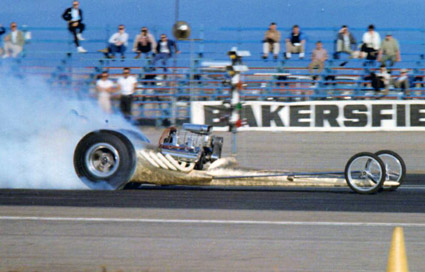 Bakersfield
1965
Bakersfield
1965
Charles
Milikin Jr Photo
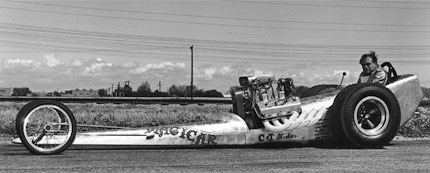 One of the greatest top
fuel drivers of all time, Jeep Hampshire.
One of the greatest top
fuel drivers of all time, Jeep Hampshire.
Kaye Trapp photo

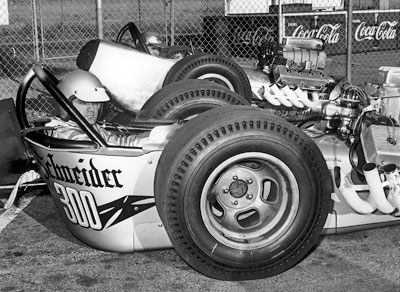
Brothers Ron and Jeep Hampshire
get ready for a much publicized two out of three match race at
"Lion's" in 1965. Jeep in the Magicar (far lane) and
Ronnie in Sid Waterman's fueler.
Kaye Trapp photo

Ron leaves on Jeep in the first
round of their two out of three match race at "Lion's".
But Ron has to "click it" just short of the light.
"Magicar" traction at work here.
Kaye Trapp photo

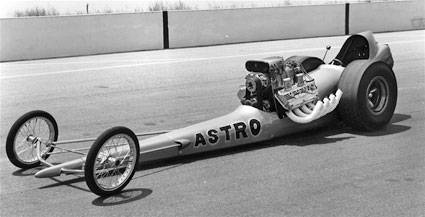
Body and Paint Change are shown
here on the big right hander after the straight away at Riverside
Raceway. This was at the Second Annual "Hot Rod Magazine"
Championships. The original open chute tail received a canopy
for the enclosed tail look.
Kaye Trapp photo
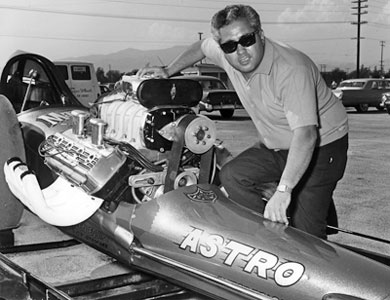
Ernie Chavez, owner of "Astro
Enterprises" poses with the "Magicar", now blanketed
with its third candy apple red paint job. Paint and lettering
by Cerny and Kelly.
Kaye Trapp photo
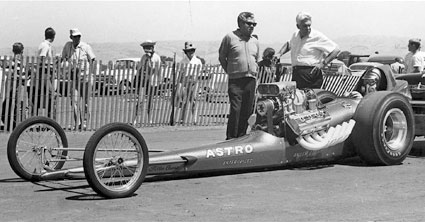

These are photos taken of the
"Magicar" with still another paint job and the addition
of the tail it currently has, built by Ron Covell. Soon the nose
would be pulled and the car lengthened by two feet. And finally
before it was put up in the rafters of Ray Monteago's shop, the
tail was remove and the roll cage modified.
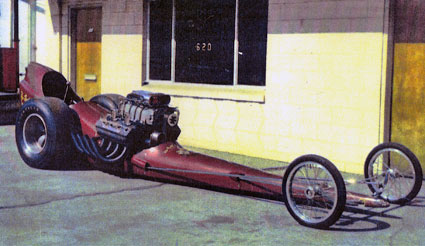
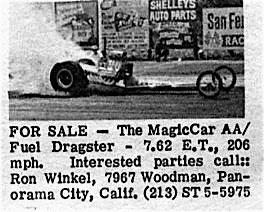
In September of 1965 the "Magicar"
came back to Fuller who sold the car to Ray Monteago. The car
was driven by Jimmy Lynn and after being lengthened by two feet
was finally stripped of it's fire breathing Chrysler and put
up in the rafters of Monteago's machine shop where it stayed
for 15 years. Then in the late 1970's, nostalgia drag racing
enthusiast Louie Poole, acquired the car and took it for Roy
Brizio's shop in San Francisco where it was reassembled and brought
to nostalgia event in the area. The car then changed hands several
times and finally wound up being purchased in 1990 by Bill Pitts
of Carlsbad California.
During its high performance years
with Winkel, Trapp, Fuller and with Ray Monteago, the car went
through three body changes and four paint jobs. All of those
changes are currently reflected in the cars appearance today.



It was in 1978 or so that Louie
Poole accidentally stumbled on to the remains of the "Magicar".
It was hanging in the rafters of Ray Monteago's shop in Belmont,
California and needed a lot of work to be brought back to its
basic configuration. Louie purchased the remains without knowing,
it's identity!
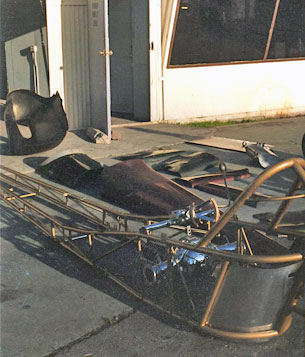
Assembly begins, but not before
some major chassis work needs to occur. The roll bar had been
raised to provide added protection for its driver. So, in order
to install the tail, the cage needed to be shortened. The frame
had been extended by two or three feet and needed to be shorted
again. Also, the torsion bar suspension had to be removed and
the rubber biscuit front suspension reassembled. Poole contacted
Fuller who provided much needed information.
 It was at Roy Brizio's
shop in San Francisco, that the "Magicar" began to
look like her old self.
It was at Roy Brizio's
shop in San Francisco, that the "Magicar" began to
look like her old self.

And so, with a fresh red paint
job and Louie Poole in the seat, the "Magicar" reappeared
at Baylands Raceway in about 1980. This is the car's very first
run. Louie would make exhibition passes in the car for a year
or two more, then the car would change hands several times before
finally winding up with John Barrett of Oklahoma.

All stories must have a beginning
and for Bill Pitts, his time with the "Magicar" really
began in Santee, California in 1989 where a friend of his got
word of an old dragster trailer next to a house. In that trailer
was a long forgotten fueler from the past which Pitts purchased
for $2,400.00. That car was the Baney/Prudhomme SOHC Ford "Shelby
Super Snake". Needless to say, it had a sterling pedigree
including the first fuel dragster in the 6's at an NHRA national
event. What were Bills reasons for buying an old forgotten fueler
in the first place? Well that's a long story in itself, which
he won't go into without a book deal. Just know that he felt
that something "big" was missing from drag racing and
he wanted to bring a piece of it back.
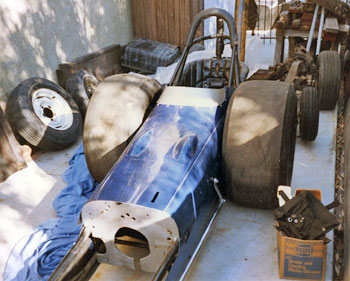
The Tony Nancy upholstery and
Tom Hanna body covered the 178 inch wheel based Don Long chassis
that at one time, held a big blown nitro burning Ed Pink SOHC
Ford. Restoring this car would be cost prohibitive. Pitts knew
that he wouldn't be financially up to the task. So, armed with
pictures of this car he went to an NDRA event at Famoso Raceway
in 1990 and was stunned to see the "Magicar" on display.
Jon Barrett of Oklahoma, owned the car and was frustrated about
his inability to make a pass in the car. The NDRA was requiring
him to make the necessary changes to the roll cage to pass tech,
but he didn't want to cut up the car. Pitts showed Barrett pictures
of the Don Long car and it was determined that it would be easier
to make the necessary modifications to it to allow Barrett to
race, so he suggested to Pitts, "Why don't we trade?"
Pitts "lifted off" at that moment and hasn't
been down since.
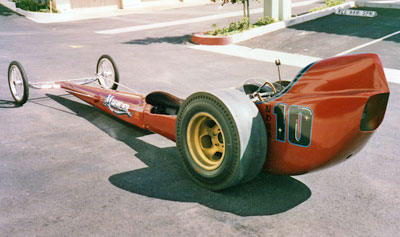
Three months later, Barrett pulled
into Carlsbad with the car, minus the motor, clutch, and high
gear shaft. The trade was made and Pitts began his incredible
journey with the "Magicar".

First stop for the car was Pitts'
Mom and Dad's garage. He lived with his wife in a condominium
and the car needed to be someplace safe. His Dad had taken him
to the drag races in the mid-60's and Bill thinks he enjoyed
having the car at his house. His Mom was a good sport about it
too.
But he needed to find a 392 Chrysler
Hemi for the car and it looked like he should just start gathering
pieces and slowly but surely assemble a fuel motor to put in
the beast.

So Pitts purchased his first
392...one that was a little too far gone to be anything but a
boat anchor.

When Pitts took the old iron
"Marine" 92, to the late Bill Hooper for examination,
he thought he was crazy. So this '92 wound up in the dump. Pitts
went back to square one, determined to find a motor that was
already built for this application. And that's when he got word
of an engine in Gary Cochran's Fountain Valley garage. To the
delight of Mrs. C, Mr. "C" sold Pitts his last assembled
392 and loaded the rest of his spare parts into his pickup truck.
In one fell swoop, Pitts had a hemi with a history to boot!

It was the summer of 1990 and
after Pitts acquired a set of zoomies and an Enderle "Bug
Catcher" from Guy Cope that he assembled the car in "display
form" only, minus a drive shaft, clutch, and fly wheel,
and took it out to show at Carlsbad Raceway. It was at this event
that Pitts met Rick MacDonald, who eventually became the car's
crew chief, so-to-speak. Rick gained a lot of nitro motor experience
as a crew member for the top fuel teams of Ruffalo & Ehlen
and Mark Danekas thereafter. Though not directly involved in
the car right away, his abilities would eventually move the "Magicar"
team, deep into the "NItro Zone".
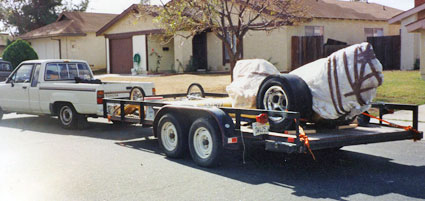
During the car's stay at Pitts'
folks house a "biker" by the name of Tom Morris, who
lived down the street, took an interest in the car and the end
result was a dynamite paint job by Morris and lettering from
another local with a history of lettering race cars--Roy Potter.
Tom's early involvement was key to the cars success and assembling
and running the beast.
Here, in 1992, looking like she's
ready for "safe sex", the "Magicar" is packaged
to make the journey to the inaugural California Hot Rod Reunion.
Of course Pitts had made contact with the original partners,
not only respectfully asking them if he could put their names
back on the car, but also asking them to join him for any and
all of the events they attended. All (Winkle, Trapp and Hampshire)
were very cordial and happy to oblige.

At this first CHRR, the car was
invited to be on display in Lee Schelin's "Standard 1320"
booth. It was here that Pitts met a few of the original partners
for the first time. Here's one of his true racing heroes, Jeep
Hampshire. At that first CHRR he also met Kent and Evelyn Fuller,
and Gerry Glenn (who also drove the car).
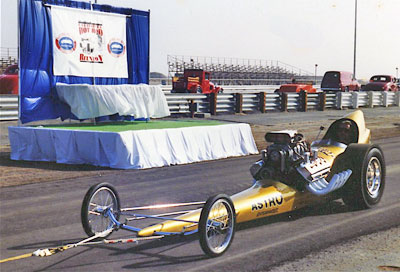
It's hard to see here, but this
is Gerry "The Hunter" Glenn being pulled in one of
the car parades that took place that first weekend. Moments like
this were letting Pitts know that he was on the right path with
the car.
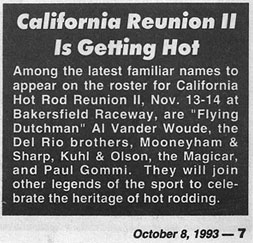
After a year of totally disassembling
the motor and buying what was necessary to actually start it,
Pitts was shocked to see this promotional ad in "National
Dragster" listing the "Magicar" as an actual "headliner"
for CHRR II. Bill never thought that it would ever carry that
much weight. During that time in 1993, Tom Morris helped Pitts
out a great deal getting the motor ready to fire. Gene Adams
was also a big help when it came to setting up the injection
system to run straight alcohol. November of 1993 - the car was
ready to fire-up on "Memory Lane", if it was allowed.
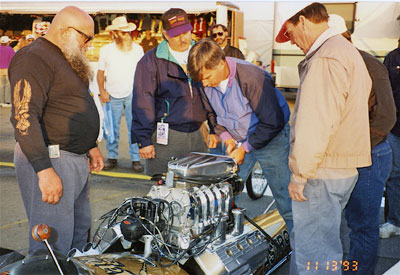
CHRR II, with the car set up
on "Memory Lane", a rag tag bunch of firemen and a
"biker" tried to figure out how to start a "Hemi".
Tom Morris watches carefully as Pitts sticks the blower starter
on the car. To Bills left, John Manard, his fire engineer at
the time (Pitts is a Captain on the San Diego City Fire Department),
and Art Robertson, his battalion chief, all have that same blank
stare, and are all thinking, "Now what are we going to do?!"
Also of note, in the background, with the cowboy hat on is the
owner of a future Cacklefest car (Stellings & Hampshire),
Dennis Prater.
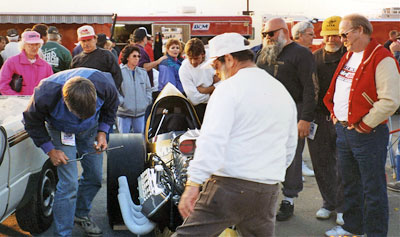
After much head scratching, they
started to draw some "knowledge on the subject". Off
to the right is the "Magicar's" original owner and
motorman, Ron Winkel. Mike Allison (son of the late Ed Allison),
Pitts first "test pilot" is looking into the driver's
compartment. Help was arriving so they just keep "circling
the wagons", hoping for "experts".

Finally a true expert arrives.
Bruce Walker, of "Childs and Albert" moved in to assist.
The two guys on the right, will stick a $20.00 bill in Pitts'
pocket to help cover nitro costs every year thereafter. Mike
Allison perches himself on the slick.
To make a long story short, she
fired...no driveshaft, no clutch, and no flywheel. They were
just a bunch of guys who wanted that car the live again. And
with the help of people that Pitts never expected would care
about his little show, they were successful.

During the time between CHRR
2 and 3, saw the "Magicar" on display for a couple
of weeks at the "San Diego Automotive Museum". It was
good to see a digger in that show. And of course, one of the
main functions of the "Magicar" was to reel back in
wayward drag racers of the past. Chuck Bayuk (right) was a helpless
victim of the cars allure. The end result was that Chuck, a handyman
by trade, spent $50,000.00 or so on a nostalgia front motor car
and is back in the thick of things at all the Goodguys events.
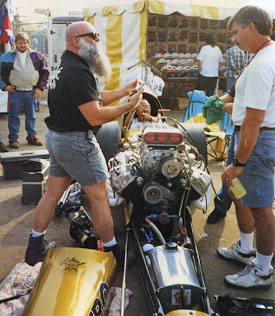
The learning curve was a long
one with the "Magicar". Pitts and "crew"
struggled along, running the car on just straight alcohol for
quite a few years, and here's an example of why. Tommy Morris
has just snapped the end of the ratchet off in the top pulley
while trying to "back it down" after Pitts FILLED the
blower with alcohol from a boost bottle he was using at the time.
In the beginning, they weren't that good at making her run.
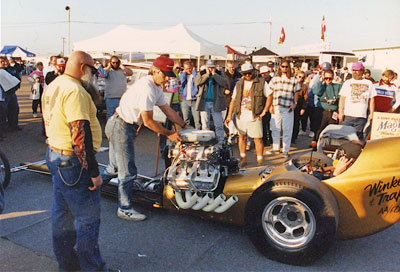
But usually, when she ran, she
drew a good sized crowd. During the "straight alcohol period",
as Pitts likes to remember it, they put the guys that came up
with them in the car. They, of course, were hoping that those
with history didn't mind them "doing their thing".
And, as far as Bill knows, they didn't mind.
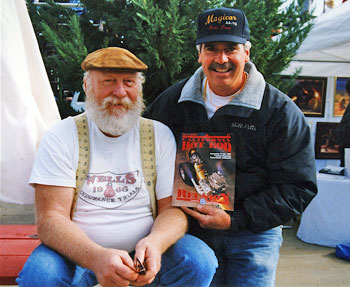
Here's a man that Bill is so
happy to know -- Kent Fuller. Fuller has told Pitts that he feels
good about what his old "Magicar" has been doing since
he brought her back for all to see. Here is a shot with the CHRR
program for one year where a picture taken by Robert Genat was
used on the cover. It made "Fuller" smile! That's a
good thing.
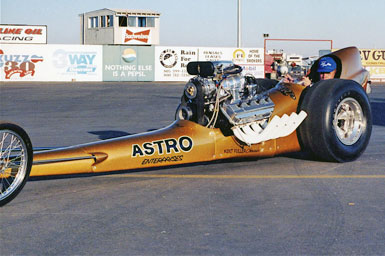
After all these years Jeep is
still very comfortable in the car, as they tow it during the
parade of cars that took place on late Saturday afternoon at
the 1997 CHRR.

In 1998 Rick MacDonald (above),
Tom Morris, John Weidler and Bill Pitts tear down the motor yet
again. This time with the express purpose of moving the car back
in to the "nitro zone". It had been a long time coming,
but then it seemed the only logical and progressive step to take.

And with their arrival in Cackle
Country (1998 CHRR), more "heroes" began to pay them
a visit. Here Don Ewald tries the "Magicar" on for
size.

The legendary Phil Hobbs joins
in on the fun. Do you think Pitts is like happy about all this?
You have no idea!

Tom Hanna, body man supreme,
is enjoying his moment in the "Magicar". Rumor has
it that it was this short stay in Pitts' car that prompted Hanna
to build his own "ultimate" Cacklefest dragster.
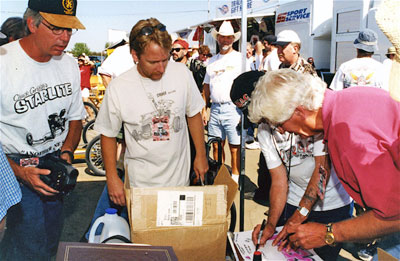
One of the truly great benefits
of caring for an old fueler with history is the people that just
hang around from time to time. Here is the late Eric Fuller working
with the late Pete Millar and Pete Starrett, to acquire and autographed
poster for a friend who is under the weather. Two of these three
guys are gone now, but they are certainly NOT forgotten. Tom West Photo
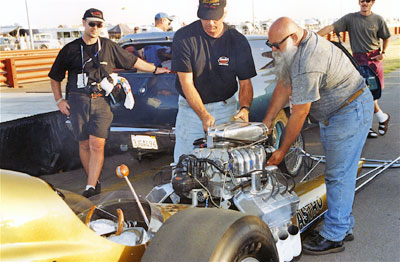
The 1999 CHRR was just full of
incredible moments for the "Magicar" team. Here was
the ultimate honor... This was the time that the "Memorial
Ceremony" was to be held. It came at the end of the day
on Saturday. And just before it was about to take place, Steve
Gibbs asked Pitts if they would be able to fire up the "Magicar"
after the reading of the names of those who passed away that
year. Pitts couldn't believe it! What an opportunity! So with
the help of Tom Morris and the rest of the "Magicar"
crew, they rolled the car out in front of the grandstands for
a VERY IMPORTANT fire up. It was do or die time for our little
show! Tom West Photo

And so, with Tom Morris looking
on and Lil' Tommy Larkin's son, Trevor, in the seat, they made
"magic" for everyone. What a moment for the "Magicar"
and everyone connected with her. The "Magicar", some
35 years after she debuted on a drag strip was finally living
up to its true potential. But what was much more significant
for histories sake -- Cacklefest was born.

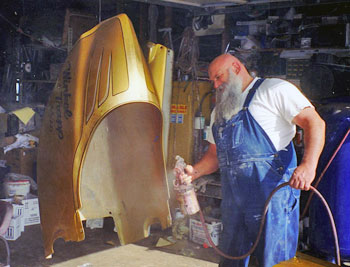
Into the new millennium and the
"Magicar" team is PUMPED after such a successful 1999
CHRR showing. They decided it was time to give the old "gold
tooth" a more aggressive look. Tommy Morris and Roy Potter
join forces, once again, to give the car some scallops, and what
do they decide to fill the scallops with? Why more gold leaf,
of course. You can never have too much gold leaf on the old "Magicar".

By 2000, Tommy and Bill had become
"brothers". Here Morris is letting Pitts know how he
feels about his suggestion to change the scallops a bit. Pitts
decided to not bring up the subject again.

During the "off season",
the word went out that the 2000 CHRR would be the first year
of a new deal called Cacklefest, coined by Greg Sharp. That put
Pitts in the position of coupling up the old "Magicar"
and with the help of Tom Morris, Rick MacDonald, and John Weidler,
the bent and twisted "Magicar" was MADE to line up.
Note the rather large pry bar/screwdriver at the bottom of the
picture.
 Showtime - push start
sucessful for Cacklefest One in 2000.
Showtime - push start
sucessful for Cacklefest One in 2000.


Here's a lot of history in one
shot! Lou Senter and Jim Diest. For Pitts, the "Magicar's"
greatest asset is its ability to attractive many of racing's
finest personalities. It also has given him the courage to introduce
himself to guys he read about in the magazines years ago, but
never thought he'd meet.
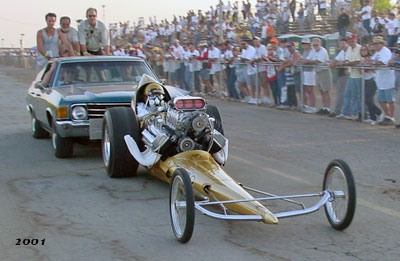
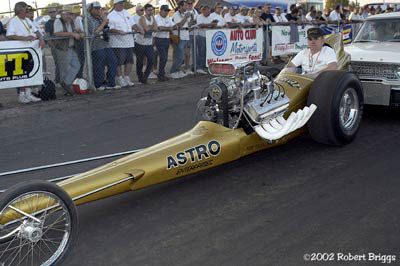 Pre Cacklefest parade
in 2002
Pre Cacklefest parade
in 2002
 Push start Cacklefest
2002
Push start Cacklefest
2002
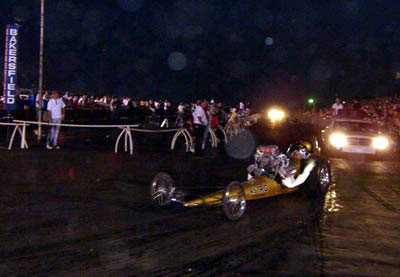
 Cacklefest 2002
Cacklefest 2002
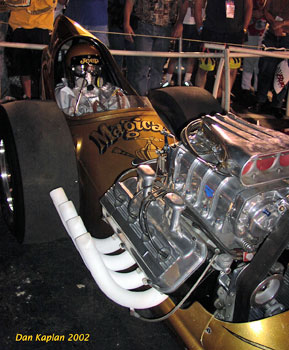 2002 Ring-Of-Fire
2002 Ring-Of-Fire

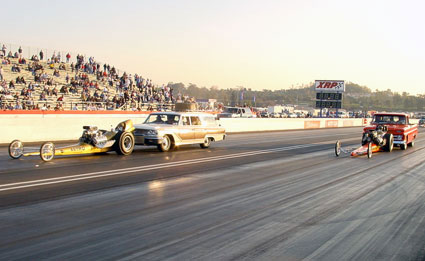 Push start at the 2003
NHRA Winternationals Cacklefest.
Push start at the 2003
NHRA Winternationals Cacklefest.
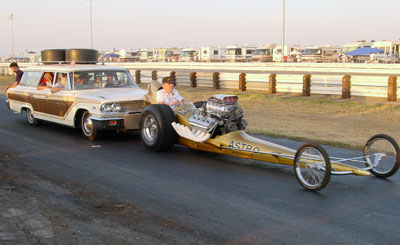
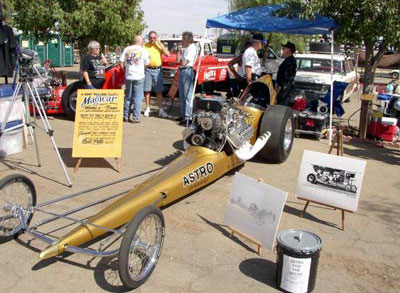 Magicar "pit"
Magicar "pit"
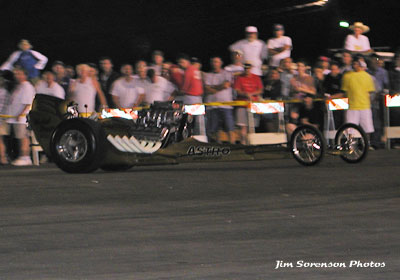 Hampshire going to his
spot and parked during the 2003 Cacklefest.
Hampshire going to his
spot and parked during the 2003 Cacklefest.
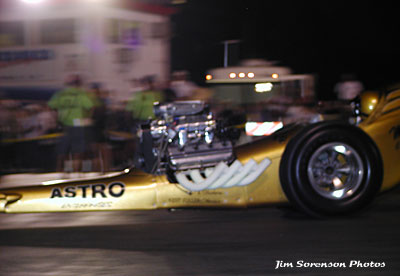
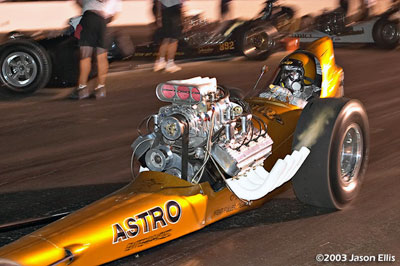

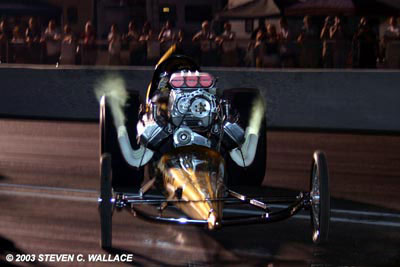
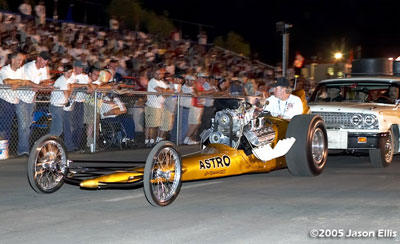
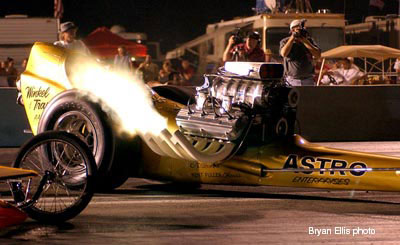
All the great memories aside,
the Magicar has been a star at every Cacklefest since conception.
It is this editors hope that Bill, Jeep, Rick and the whole Magicar
crew will continue to be in the forefront of the legacy they
were so instrumental in starting.
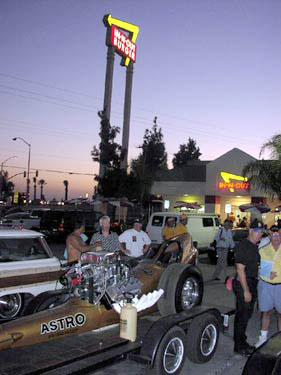
And then there's the other tradition
they started - the annual participation in the "Mini Cacklefest"
held after the CHRR on Sunday evening at the Bakersfield In N
Out Burger where the manager welcomes the attention. It's the
last nitro fix before everyone goes home. For the last five years
Bill Pitts' "Magicar" and the Vagabond have fired up
in the parking lot packed with racers, fans and locals who can't
quite grasp what they are seeing - let alone hearing. What better
way to end the best weekend of the year than a double-double
animal style and 4 gallons of nitro!

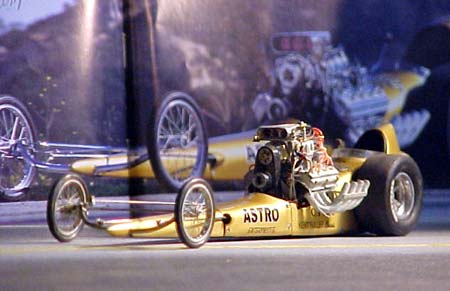
The "MagiCar" AA/FD
was originally built by chassis guru Kent Fuller in 1963 . This
incredible replica by Roger "Riceman" Lee was built
using information from Kent & Evelyn Fuller, Kaye Trapp Photos,
Bill Pitts and WDIFL.com. It has over 400 scratch built parts.
It features functional steering, trick "MagiCar" front
axle and hand made front wheels. The scratch built, removable
body is made of .016 brass and was hand formed over the detail
1/25 scale Fuller chassis that is complete with unique suspended
inner frame (see below). For "power" Roger installed
a super-detailed blown fuel 392 Chrysler hemi hooked to a completely
scratch built drive line.
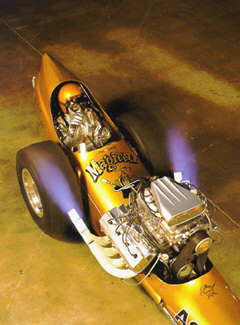
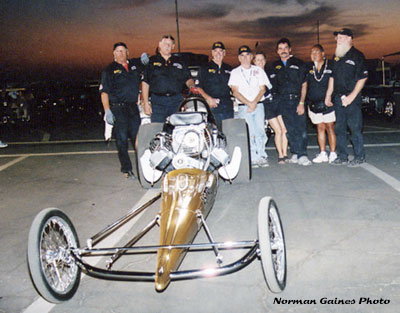
If you plan on
attending the next California Hot Rod Reunion (as you should)
be sure to drop by the Magicar pit on Memory Lane to check out
this beauty up close and personal. Be sure to introduce yourself
to the biggest fan drag racing has ever known... Bill Pitts and
his crew of more fans.

 |



